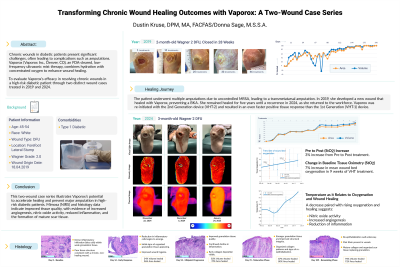Case Series/Study
(CS-075) Transforming Chronic Wound Healing Outcomes with Vaporous Hyperoxia Therapy (VHT®): A Two-wound Case Series

Methods: To evaluate VHT’s efficacy in resolving chronic wounds in a high-risk diabetic patient through two distinct wound cases treated in 2019 and 2024.
Methods:
A 51-year-old Caucasian female with type 1 diabetes (HbA1c 7.8, historically well-controlled) and a history of anemia presented with chronic wounds resistant to standard treatments. In 2019, she had a Wagner Grade 2 diabetic foot ulcer (DFU) on a forefoot stump following a trans metatarsal amputation (TMA). Standard care, including negative pressure wound therapy, skin grafts, and other advanced therapies, failed to achieve closure. In 2024, the same patient developed a new DFU on the right foot, which worsened under initial treatment with collagen, Medi honey, and topical antibiotics. Healing progress was monitored using advanced imaging techniques such as Near-Infrared Spectroscopy (NIRS) and thermography imaging.
Results:
Wound #1 (2019): At VHT initiation, the wound measured 1.4 x 1.6 x 0.3 cm with an area of 2.24 cm² and volume of 0.672 cm³. After 4 weeks, the wound achieved a 45.98% reduction in area and a 64.88% reduction in volume. By 8 weeks, the wound showed a 64.29% reduction in area and a 76.19% reduction in volume, ultimately achieving 100% resolution after 46 treatments over 28 weeks These cases highlight VHT’s transformative potential in reversing chronic wound deterioration in complex diabetic cases. For this patient, who previously experienced treatment failures, VHT facilitated remarkable healing outcomes.
Wound #2 (2024): Initially measured 1.2 x 1.9 x 0.5 cm with bioburden and pale granulation tissue. After 4 weeks of VHT®, the wound achieved a 56.6% reduction in area and a 74.0% reduction in volume. At 7 weeks, the wound showed an 89.5% reduction in volume, measuring 0.6 x 1.0 x 0.2 cm, and is on track to fully resolve with continued treatment.
At baseline (day zero), a temperature gradient was observed between the wound and periwound areas, suggestive of a potential infection. The mean tissue oxygenation at the wound bed was 90% ± 14%, with a hypoxic area present (St2 < 39%). Following four weeks of treatment, the temperature gradient persisted, though wound bed oxygenation improved to 91% ± 11%, and the hypoxic area was no longer detectable. By six weeks, both the temperature gradient and hypoxic area had resolved, indicating positive healing trajectory.
Discussion:

.jpg)